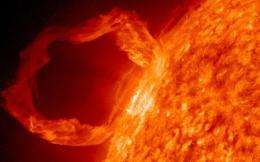May 17, 2012 report
Kepler satellite telescope reveals hundreds of superflares on distant stars

(Phys.org) -- Here on Earth we are occasionally concerned about solar flares due to the impact they can have on our electrical systems. But our solar flares are puny when compared to so-called superflares that occur with other stars. A new research study by a team from Japan’s Kyoto University has found after studying one patch of sky over a 120 day period in 1990 using data from the Kepler telescope, that superflares are rather common, and as they describe in their paper published in the journal Nature, some are a billion times as powerful as those that occur with our own sun.
Scientists have known about superflares for some time, though little is actually known about them. Nonetheless, over the past several years a near consensus had been reached regarding the reasons for their occurrence. Most in the field agreed that they were caused by interactions with what are known as “hot Jupiters,” huge planets in close proximity to the star. This new study undermines that theory; out of 365 superflares spotted occurring with 148 stars, not one of them had a hot Jupiter nearby. Because of this, astrophysicists are once again in the dark and must now go back and rethink the possibilities. Some have already suggested that instead of a hot Jupiter, perhaps there is a hot Earth situation occurring, i.e. a more distant cooler planet interacting with the star. Unfortunately, such an interaction would be far more difficult to observe because such planets wouldn’t change the amount of light observed by Kepler as would hot Jupiters when they pass between our planet and their star.
The team also found that superflares occur more often with faster spinning stars; of the 365 superflares observed, only 101 occurred with slow rotating stars. They also found that stars that gave rise to superflares almost always had large sunspots as well. For these reasons, and because there is no evidence of such a large flare over the past 2000 years, the team doesn’t believe our own sun is capable of producing such large flares, which is good, because just one blast would destroy our ozone layer, making our planet uninhabitable in short order.
Scientists believe that flares from our sun come about when magnetic field lines that are connected to magnetically active parts on the sun, which we observe as sun spots, snap like a cut wire, sending electrically charged particles into space. Unfortunately, the same model doesn’t appear to hold for superflares because of the differences in scale. Thus, more research will need to be done to see if other models or theories can be built to help better explain this mysterious phenomenon.
More information: Superflares on solar-type stars, Nature (2012) doi:10.1038/nature11063
Solar flares are caused by the sudden release of magnetic energy stored near sunspots. They release 1029 to 1032 ergs of energy on a timescale of hours. Similar flares have been observed on many stars, with larger ‘superflares’ seen on a variety of stars, some of which are rapidly rotating4, 5 and some of which are of ordinary solar type. The small number of superflares observed on solar-type stars has hitherto precluded a detailed study of them. Here we report observations of 365 superflares, including some from slowly rotating solar-type stars, from about 83,000 stars observed over 120 days. Quasi-periodic brightness modulations observed in the solar-type stars suggest that they have much larger starspots than does the Sun. The maximum energy of the flare is not correlated with the stellar rotation period, but the data suggest that superflares occur more frequently on rapidly rotating stars. It has been proposed that hot Jupiters may be important in the generation of superflares on solar-type stars, but none have been discovered around the stars that we have studied, indicating that hot Jupiters associated with superflares are rare.
Journal information: Nature
© 2012 Phys.Org




















